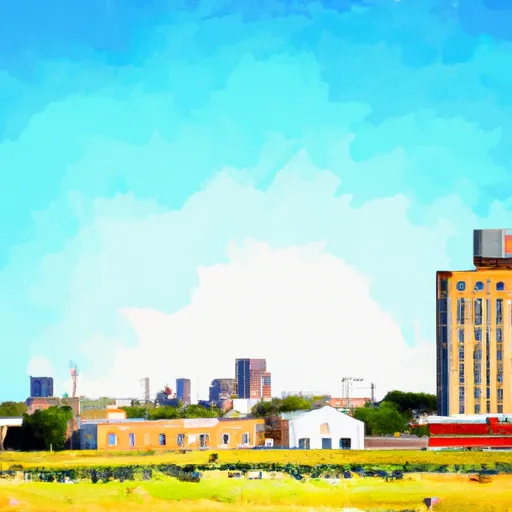-
 Snoflo Premium
Snoflo Premium
Get unlimited access to all our content
With no Ad interruptions! - Start Your Free Trial Login with existing account
Wellman
Eden Index
Climate
9.1
•
Recreation
1.7
•
Community
0.7
•
Safeguard
4.4/10

Wellman, Texas is a small town located in Terry County, West Texas. Known for its warm climate and arid landscape, the town experiences hot summers with temperatures averaging in the high 90s°F (35-37°C), while winters are mild, with temperatures ranging from the low 30s°F to the mid-50s°F (-1 to 10°C). Annual precipitation is limited, with the majority occurring during the summer months.
Hydrology constituents in Wellman are primarily composed of underground aquifers, including the Ogallala Aquifer, which plays a vital role in supplying water to the region. Groundwater is crucial for domestic, agricultural, and industrial uses in the area.
Despite its arid surroundings, Wellman offers a variety of outdoor recreation opportunities. The nearby Terry County Park provides a serene setting for picnicking, nature walks, and birdwatching. Fishing enthusiasts can indulge in angling at Lake Alan Henry, located a short drive from Wellman, where the waters are abundant with bass, catfish, and crappie. Additionally, the town's rural landscape allows for activities such as hiking, camping, and stargazing, providing a peaceful escape into nature.
What is the Eden Index?
The Snoflo Eden Index serves as a comprehensive rating system for regions, evaluating their desirability through a holistic assessment of climate health, outdoor recreation opportunities, and natural disaster risk, acknowledging the profound impact of these factors on livability and well-being.
Climate Health Indicator (CHI): 9.1
Wellman receives approximately
432mm of rain per year,
with humidity levels near 75%
and air temperatures averaging around
16°C.
Wellman has a plant hardyness factor of
7, meaning
plants and agriculture in this region tend to thrive during the non-winter months.
By considering the ideal temperature range, reliable water supplies, clean air, and stable seasonal rain or snowpacks, the Climate Health Indicator (CHI) underscores the significance of a healthy climate as the foundation for quality living.
A healthy climate is paramount for ensuring a high quality of life and livability in a region, fostering both physical well-being and environmental harmony. This can be characterized by ideal temperatures, reliable access to water supplies, clean air, and consistent seasonal rain or snowpacks.
Weather Forecast
Streamflow Conditions
Upper Colorado
Area Rivers
Upper Colorado
Snowpack Depths
Upper Colorado
Reservoir Storage Capacity
Upper Colorado
Groundwater Levels
Recreational Opportunity Index (ROI): 1.7
The Recreational Opportunity Index (ROI) recognizes the value of outdoor recreational options, such as parks, hiking trails, camping sites, and fishing spots, while acknowledging that climate plays a pivotal role in ensuring the comfort and consistency of these experiences.
Access to outdoor recreational opportunities, encompassing activities such as parks, hiking, camping, and fishing, is crucial for overall well-being, and the climate plays a pivotal role in enabling and enhancing these experiences, ensuring that individuals can engage in nature-based activities comfortably and consistently.
Camping Areas
| Campground | Campsites | Reservations | Toilets | Showers | Elevation |
|---|---|---|---|---|---|
| Seminole City Park | 10 | 3,311 ft | |||
| Coleman City RV Park | None | 3,272 ft | |||
| Chamber of Commerce Park - Andrews | 6 | 3,176 ft | |||
| Municipal Trailer Park - Andrews | 12 | 3,170 ft | |||
| Levelland City RV Park | None | 3,507 ft | |||
| Chamber of Commerce RV Park - Seagraves | 5 | 3,346 ft | |||
| Waylon Jennings | 56 | 3,557 ft | |||
| Gaines County Park | 18 | 3,324 ft | |||
| Florey City Park | 52 | 3,164 ft |
Nearby Ski Areas
Catastrophe Safeguard Index (CSI):
The Catastrophe Safeguard Index (CSI) recognizes that natural disaster risk, encompassing floods, fires, hurricanes, and tornadoes, can drastically affect safety and the overall appeal of an area.
The level of natural disaster risk in a region significantly affects safety and the overall livability, with climate change amplifying these risks by potentially increasing the frequency and intensity of events like floods, fires, hurricanes, and tornadoes, thereby posing substantial challenges to community resilience and well-being.
Community Resilience Indicator (CRI): 0.7
The Community Resilience Indicator (CRI) recognizes that education, healthcare, and socioeconomics are crucial to the well-being of a region. The CRI acknowledges the profound impact of these elements on residents' overall quality of life. By evaluating educational resources, healthcare accessibility, and economic inclusivity, the index captures the essential aspects that contribute to a thriving community, fostering resident satisfaction, equity, and social cohesion.

